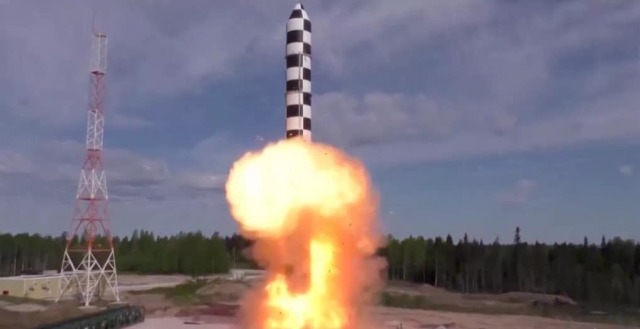Since August 1945, the only thing that protects the world from a global war is the possibility of a retaliatory strike, dangerous for nuclear powers. Until now, the main weapon of Russian nuclear deterrence has been "Satan", as NATO calls her, or "Voivode", as she is called in Russia. Now a different missile system has been adopted, much more dangerous and better protected. Will he be able to change the strategic balance sufficiently so that the conflict between Russia and NATO will continue to remain unacceptable for its participants?
More than a decade and a half ago, the famous rocket designer Yuri Solomonov (the creator of the "Mace") said : "Liquid—fuel rockets are the day before yesterday." These words sound very alarming: both then and now, most of Russia's nuclear warheads are on such missiles. But Western warheads are on solid-fuel missiles. Solomonov insisted that it was irrational to spend money on developing a liquid—fuel replacement for the Soviet Voivode with ten warheads.
Why? The designer replied as follows: "The task of overcoming modern missile defense with liquid-fueled missiles is unsolvable, since they are not adaptive to such systems that have received space-based elements. Such missiles have a very large active area of operation of the first stages and a large flight altitude at which they can be intercepted."
What is meant is this: a solid-fuel rocket is accelerated by the burning of huge powder bombs. gorenje. They manage to burn out faster than the fuel of a liquid-fuel rocket burns out. Consequently, the acceleration section of the trajectory on which it is most desirable to shoot down a rocket will be shorter for a solid-fuel system, and longer for a liquid-fuel system. And the rocket can throw out false targets only after the acceleration is completed: otherwise the distracting "blanks" will have insufficient speed to interest the enemy.
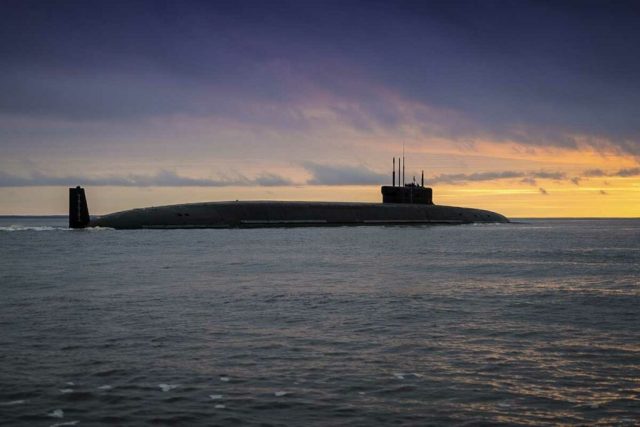
Solomonov's ideas were embodied in equipping 16 Borey-type Russian submarines with solid-fuel "Maces". Each such boat can carry 96-160 nuclear warheads delivered by its ICBMs to targets. Liquid rockets for submarines of moderate size are less suitable: after all, they are usually much larger and more massive than solid-fuel ones
Image source: Wikimedia Commons
It should be noted that Yuri Solomonov was a little hasty. The United States does not and has never had a missile defense system whose anti-missiles are carried into space. However, in the coming years, the prices for launching cargo into orbit in the States may fall many times, but in Russia, while they are not copying Starship there yet, this is unlikely to happen. Consequently, Washington will be able to start placing elements of the missile defense system in space, while Moscow, due to the lack of cheap reusable carriers, will not.
So, if Solomonov is right, the adoption of the Sarmat is a major strategic mistake. Is it so? Before answering this question, let's take a closer look at "Sarmat".
Why is "Sarmat" liquid fuel?
The advantages that Solomonov is talking about look solid. Intercepting solid-fuel rockets from space is more difficult than liquid-fuel rockets, because it has less acceleration time, right? Meanwhile, the removal of missile defense systems into space by the States was declared back in the 1980s. Why did the developers of Sarmat — and the Russian state as a whole — make the main bet on liquid-fueled missiles? Why are most of the Russian warheads on them?
Let's take a look at the most "multi-headed" of the American intercontinental ballistic missiles LGM-118 Peacekeeper. We see it has ten warheads for 300 kilotons, 10 heavy false targets and 100 light false targets. Range — 9600 kilometers, weight 88 tons. The price is 700 million modern dollars apiece.
Let's compare this with the notorious "Voivode-Satan". There are also ten warheads, the power, however, is already 750 kilotons, but this is just a means of compensating for lower accuracy (Peacekeeper has it higher). A similar set of false targets and reflectors. The range, depending on the warhead, is 11-16 thousand kilometers, the mass is 211 tons. The cost is less than 12 million Soviet rubles. Like a couple of thousand "Lada" or a thousand "Volga". That is, in terms of a ton, this rocket is an order of magnitude cheaper than a passenger car.
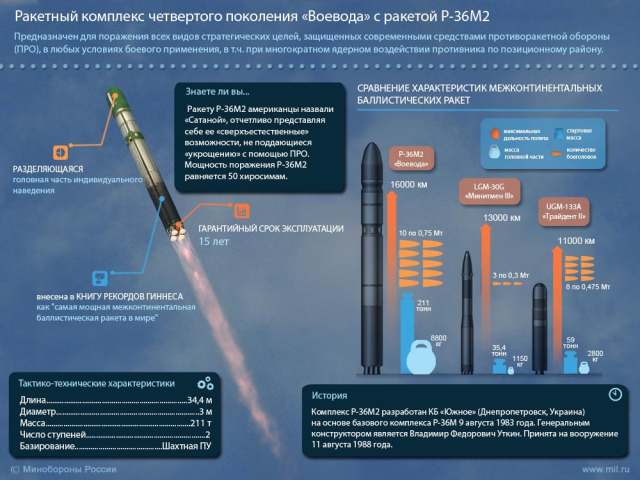
©Ministry of Defense
Can say: this is an improper comparison. In the USA they do not hide : the military industry is deeply riddled with corruption, because of which the terms of military R & D programs are fantastically stretched, as well as their cost. Well: let's throw out of the price of Peacekeeper missiles a really exorbitant share of "development expenses". And then the American counterpart, now already decommissioned, costs 70 million dollars in 1998: about 5 thousand Camry, clearly more than the P-36.
So, Peacekeeper is four to five times more expensive than its Soviet competitor, even at the official rate of "62 kopecks per dollar". The exchange rate of the Soviet ruble was greatly inflated, so in fact Peacekeeper was incredibly more expensive. You can often hear: prices in the Soviet military-industrial complex did not mean anything, they were appointed "from a fool". This is not so: they were appointed based on labor costs and material intensity. And the USSR objectively could not afford to make too expensive missiles: its GDP was noticeably smaller than that of the United States.
Why is the price of "Voivode" and Peacekeeper so different? The mass of the "American" is more than two times less, shouldn't it be cheaper? No, it shouldn't: solid-fuel rocket fuel is much more labor-intensive and difficult to produce than liquid.
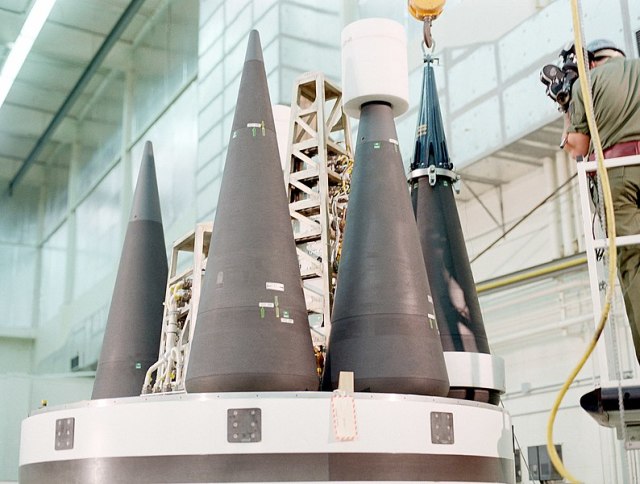
The Peacekeeper warhead looks like this
Image source: Wikimedia Commons
In addition, the specific impulse of a solid-fuel rocket engine is lower than that of a liquid-fuel one. So either the payload or the range of a solid-fuel rocket, other things being equal, "subsides" in comparison with liquid-fuel ones.
Let's take a look at "Sarmat": this is a rocket weighing 208 tons, but with a range of 18 thousand kilometers, almost twice as large as Peacekeeper. It has a cast weight of 10 tons, and Peacekeeper has only 3.6 tons. Due to this, the Sarmat has significantly higher warhead power, 750 kilotons, not 300. The circular probable deviation, according to estimates circulating in the West, is at the level of the American counterpart, which is very important: a conventional nuclear explosion, even 100 meters from a high-quality missile silo, will not disable it.
But what about the fact that it is easier to intercept a liquid-fuel missile by an American missile defense system?
High power and range seem important, but overcoming missile defense is even more important. In the end, to reach any point in the United States in a straight line, a range of 10 thousand kilometers is enough. Nuclear strikes on Australia can hardly be attributed to the top priorities: it simply does not have nuclear warheads, that is, unlike the NATO countries (and soon also Sweden and Finland, when they join NATO), it is not a target at all.
Nevertheless, the long range and the mass of the Sarmat being thrown are of great importance for overcoming the US missile defense. Firstly, 18 thousand kilometers can be used to approach the borders of the States from the south — so that then the planning combat unit reaches the targets on their territory from the south. That is, from the side where they have no missile defense. (However, the myth about the possibility of a new rocket flying through the South Pole is just a myth, this requires a range of 20 thousand kilometers).
In theory, ships with the Aegis anti-missile system based on ships can be located from the south of the United States. But against the "Vanguards" (and US attacks from the south are possible only by them) it's practically useless. It is possible to surround a large missile defense country from all sides, but this will seriously reduce Washington's ability to buy other types of weapons. And this, in fact, is one of the most important goals of the new Russian weapons systems.
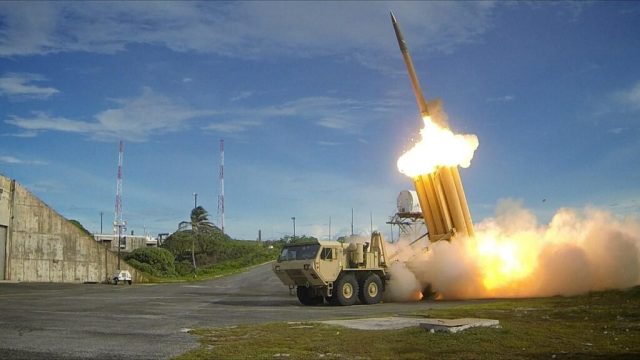
THAAD Launcher
Image source: Wikimedia Commons
Recall: one THAAD missile defense battery includes six launchers, and costs 0.8 billion dollars. At the same time, it covers a circle with a diameter of 400 kilometers. It turns out that a lot of such systems are required to cover the continental USA "in a circle". And they're not perfect either. And future interceptors will cost half a billion dollars per launcher, that is, much more expensive. It is not surprising that these programs do not pass through Congress very well, and the real number of even THAAD batteries in the USA is still homeopathic, only seven batteries .
Another important point: the Sarmat has false targets with its own engines, heavier than American missiles. It is very difficult to distinguish them from real warheads. This means that even the full cover of the American borders with a very dense missile defense will not be able to fully secure Washington in any way.
Finally, Yuri Solomonov's concerns about the downing of a liquid-fuel rocket during acceleration in the case of the Sarmat (like any Russian mine rocket) do not work. Even old liquid-fuel rockets finish acceleration no further than 300 kilometers from their mine. That is, it will gain the necessary speed even in the depths of the territory of Russia, where there is no American missile defense. The new rocket also has a reduced engine operating time, a matter of minutes. That is, she is even less vulnerable in this sense.
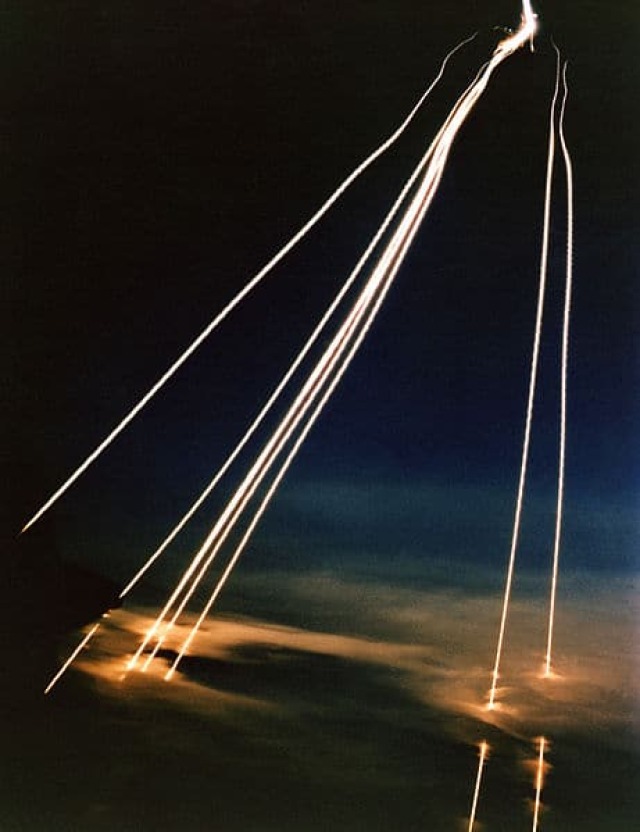
A delayed photo showing traces of the entry into the atmosphere of the warheads of an American intercontinental ballistic missile
Image source: Wikimedia Commons
Interceptor missiles, of course, can be launched into space in advance to try to attack the Sarmat over the territory of Russia. But in the same way, nothing prevents the means of countering interceptors from being launched into space in advance (except for the cost of withdrawal, of course).
For the United States, launching cargo into space will soon become much cheaper than for us. And this can really damage the strategic balance. But there's nothing you can do about it: either you copy Starship, or you will pay for its absence by increasing the threat of nuclear war.
But isn't the silo—based liquid rockets a minus?
Yuri Solomonov noted another point: a solid-fuel rocket, unlike a liquid-fuel one, can be light and compact enough to make a mobile Poplar-type complex out of it (although lighter = fewer warheads). The complex is a multi—axle machine that can stand in the forest, and tomorrow morning find itself in another forest, but hundreds of kilometers from the first one. Such a complex is really much more difficult to find than the mine where the Sarmat-type missile is based. After all, this is a huge capital structure capable of withstanding a nuclear explosion a hundred meters away from it: it will not be possible to hide it for decades in a row.
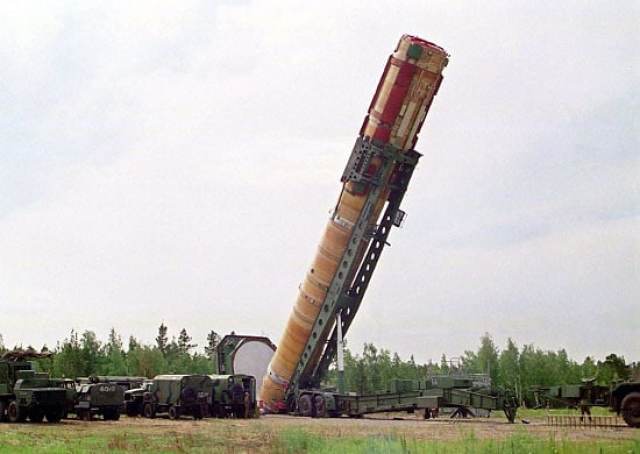
Loading one of the modifications of the R-36 into the shaft, the shaft hatch in the open position
Image source: Wikimedia Commons
Formally, Solomonov is right — but not in the case of "Sarmatian". The fact is that Mozyr will cover the mines with him. This is a fundamentally new system of protection against a nuclear warhead with ground detonation. When an American nuclear warhead falls on a mine with a Russian missile, it needs to explode at a height of 0 meters, otherwise it will not take such a serious goal. Here in this article Naked Science has already explained why feathered metal arrows, of which Mozyr releases many at once, will cut through someone else's warhead while still in the air, preventing it from disabling the liquid-fuel rocket shaft.
Because of all this, in fact, "Sarmat" will also become a defensive weapon. After wasting a nuclear warhead on such a target, the enemy will be able to inflict fewer atomic strikes on cities.
What about laser missile defense?
Indeed, in theory, an orbital laser grouping operating on the principle of a phased array antenna can cause significant damage to a rocket in space. However, Sarmat warheads can have such trajectories when they go low enough (upper atmosphere layers) for a plasma layer to appear around them. The effect of lasers through such a layer is seriously reduced. In addition, they will need to "track" the warhead with their beam, which is also not very easy.
In this sense, the planning hypersonic blocks "Avangard" are important, which "Sarmat" can output three pieces. So far, they are not really needed for a nuclear war: there are enough conventional warheads, the United States does not have any missile defense systems in space. But even if they had appeared, it would have been very difficult to intercept the Avangard.
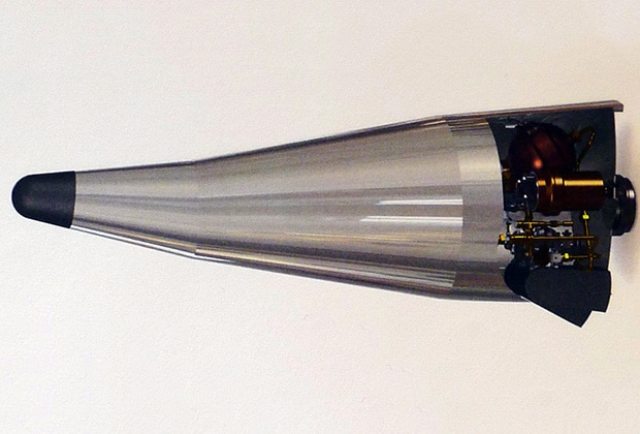
Layout of the planning combat unit of the Avangard system
Image source: Wikimedia Commons
Firstly, they are fast, up to 9.2 kilometers per second (higher than the first space, but only in short sections). Secondly, they actively maneuver in all three dimensions. Thirdly, the materials of the housing are chosen in such a way as to protect the unit from aerodynamic heating and laser irradiation. Consequently, missile defense, trying to use lasers of conventional designs against the "Vanguard" is powerless.
The most likely mechanism of such protection is ablation, that is, evaporation of the surface layer of the block, carrying away the heating energy. Similar protection systems for spacecraft head parts have been known for decades.
In general, laser missile defense is most rational on the acceleration section of the missile trajectory: its stages are much more vulnerable than warheads. It is impossible to completely cover them with ablative protection. However, for such a laser strike, it is necessary that there are no clouds over the Sarmat at the time of launch, and the laser satellite grouping has not previously been attacked by anti-satellite means itself. For example, lasers will not be able to shoot back from a cloud of small dark composite balls in orbit: a satellite grouping equipped with them simply will not see most of these targets. Which means they may well hit her.
A simple animation from the Ministry of Defense at one time caused a whole Olympiad of wit. But in the field of weapons, the quality of weapons is important, not video. And that's all right with Avangard: modern missile defense is powerless in his case / © Ministry of Defense
The time required for the creation of a space-based laser missile defense system should be approximately comparable to the time required for the creation of space launch systems for anti-satellite balls. Realistically speaking, lasers in defense against ICBMs have serious chances (however, depending on the weather). But they will not become an absolute panacea either: they will not be able to completely replace anti-missiles with them.
But it is incredibly difficult to shoot down the Avangard with anti-missiles. To do this, the anti-missile must be directed approximately to where this planning unit will be at the moment when the ground anti-missile rises to the interception height. But how do you know where this point is if Avangard is constantly and randomly changing course? In theory, an anti-aircraft missile can try to change course quickly by itself. But it is in a completely different situation: it rises from the dense layers of the atmosphere, which slows down its movement. And the Avangard falls from the upper, rarefied layers of the atmosphere, that is, it has great opportunities in terms of mobility.
What will it do for the future?
It is clear that the new capabilities of the Sarmat make it problematic to intercept even a very advanced missile defense system. No, technically it is quite possible to launch into space in advance as many Avangard interceptor units as, for example, SpaceX has Starlink satellites. That is, thousands, and then tens of thousands. Equip them with nuclear warheads for reliability. And try to intercept all the Sarmatian blocks with them. There is nothing unrealistic in this: in the coming years, the removal of cargo into space for the States will become cheap enough to do this. In such a scenario, the strategic balance would be upset, and Washington could be inclined to a more aggressive policy.
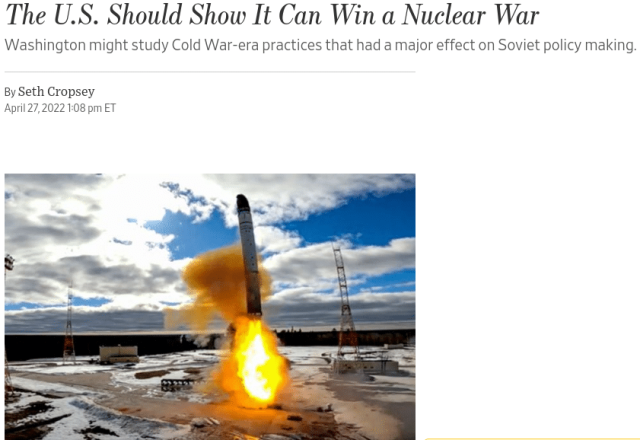
A screenshot of a real Washington Post article clearly reminds why "Sarmatov" is needed. While the United States is seriously talking about the need to demonstrate that they can "win" a nuclear war with Russia, the issue of maintaining a nuclear arsenal in a technically advanced state remains very important
Image Source: Washington Post
But in practice, this is unlikely for two reasons. Firstly, it requires very unconventional thinking from the US military. It is known from history that such thinking is rare among them.
Secondly, there is an even more important factor: the specifics of the American military-industrial complex. SpaceX, of course, will be able to bring interceptor blocks into space cheaply. But the players of the US military-industrial complex do not know how to do anything cheap. And interceptor blocks with the qualities of the "Vanguard", and even their engines will have to be made by them, and not by Ilona Mask at all. So, each interceptor unit will cost like a spaceship. So you can immediately forget about making thousands and tens of thousands of them.
And, perhaps, this is not bad. After all, there is clearly no other guarantee of global peace on today's Earth, apart from the threat of a retaliatory nuclear strike, and it is unlikely to appear in the near future.
